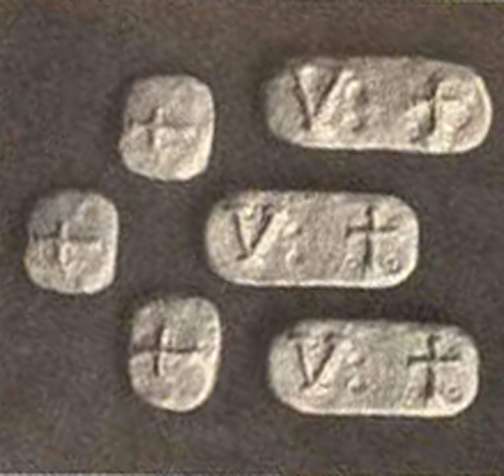buscadero
Bronze Member
TIME JULY 26, 1937
Three Grizzled Prospectors, Arrin Thorpe, Joanes Van Steck, & Antonio Hill, weary from months of prospecting, stopped their Pack Burros near the Piedra Candela Settlements in the shadow of the Santa Maria Mts on the Costa Rican - Panamanian Border one day last week
prepared to lay out Claims.
Driving the 1st Claim Stake, the ground beneath their feet gave away & the trio dropped into an abandoned Mine Shaft. Before
their startled eyes, stood 35 Gold Ingots, Ea. weighing 50#, neatly stacked against the wall. Nearby lay equipment for Panning Gold & Relics of
the days of the Spanish Conquistadors.
Stumbling down the shaft, Van Steck came upon 45 additional Ingots, which he refused to share with his partners on guard.
The 80 Ingots, Each stamped with the Seal of the Spanish Royal Crown, are valued at $1.120M. ($22.880M @ Todays Prices). Dazzled
by so much wealth, Htll, along with the native drivers, fired @ Van Steck as he returned from the Settlement, missed & fled into the Mts.
Authorities of Chiriqui Province chartered Planes & flew to the Mine, to Investigate the Discovery, which under It's Buried Treasure Law, is entitled to half of the Prospectors Find. They then rushed a Police Guard to the scene to control a stampede of the TH'ing
Natives. Authorities believe that the Tunnel belonged to the near legendary La Estrella Mine, worked by the Spanish Conquerors.
Fabulously Rich, it became "Lost" in the passing of 400 yrs. The Indians, enraged by the cruel treatment of the Spanish, are
supposed to have ambushed a mule train, killed the White Men, & buried the Gold in the Tunnel.
Joe
Three Grizzled Prospectors, Arrin Thorpe, Joanes Van Steck, & Antonio Hill, weary from months of prospecting, stopped their Pack Burros near the Piedra Candela Settlements in the shadow of the Santa Maria Mts on the Costa Rican - Panamanian Border one day last week
prepared to lay out Claims.
Driving the 1st Claim Stake, the ground beneath their feet gave away & the trio dropped into an abandoned Mine Shaft. Before
their startled eyes, stood 35 Gold Ingots, Ea. weighing 50#, neatly stacked against the wall. Nearby lay equipment for Panning Gold & Relics of
the days of the Spanish Conquistadors.
Stumbling down the shaft, Van Steck came upon 45 additional Ingots, which he refused to share with his partners on guard.
The 80 Ingots, Each stamped with the Seal of the Spanish Royal Crown, are valued at $1.120M. ($22.880M @ Todays Prices). Dazzled
by so much wealth, Htll, along with the native drivers, fired @ Van Steck as he returned from the Settlement, missed & fled into the Mts.
Authorities of Chiriqui Province chartered Planes & flew to the Mine, to Investigate the Discovery, which under It's Buried Treasure Law, is entitled to half of the Prospectors Find. They then rushed a Police Guard to the scene to control a stampede of the TH'ing
Natives. Authorities believe that the Tunnel belonged to the near legendary La Estrella Mine, worked by the Spanish Conquerors.
Fabulously Rich, it became "Lost" in the passing of 400 yrs. The Indians, enraged by the cruel treatment of the Spanish, are
supposed to have ambushed a mule train, killed the White Men, & buried the Gold in the Tunnel.
Joe








